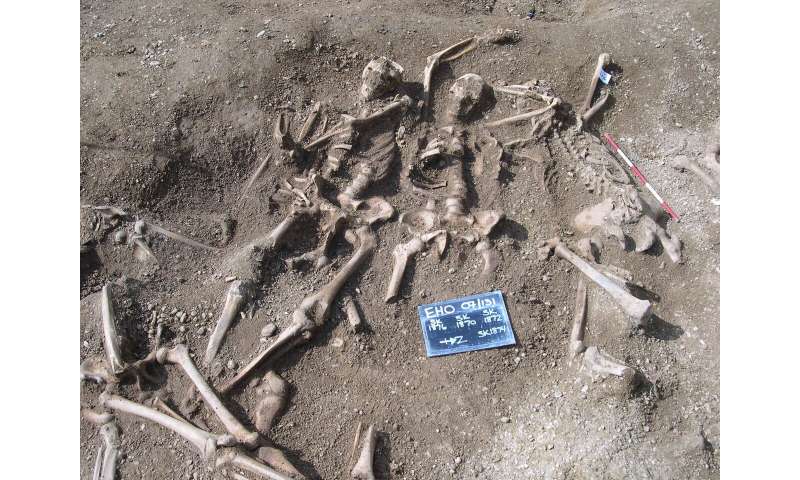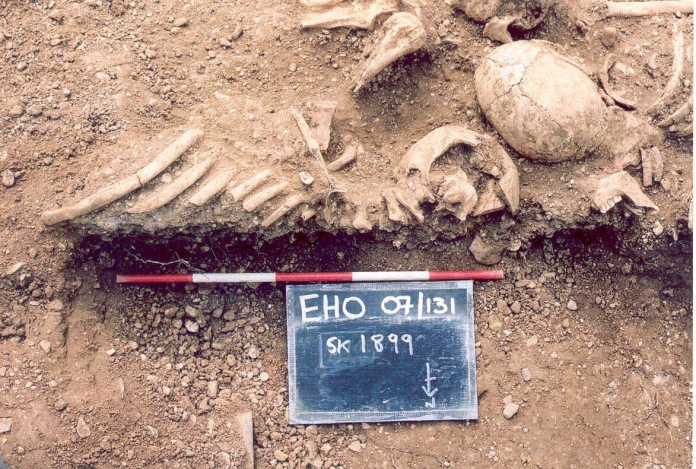Extinct strains of smallpox have been discovered by scientists in teeth of Viking skeletons, showing that the disease plagued humanity for centuries.
Smallpox killed around a third of the world population and left another third permanently scarred or blind. The disease spread from one person to another via infectious droplets. The disease was eradicated in 1980 through an effort of global vaccination. Around 300 million deaths were reported because of smallpox in the 20th century alone.
An international team of scientists discovered a new strain of this virus from teeth of Viking skeletons, from sites across northern Europe. The study was led by Professor Eske Willerslev, of St John’s College, University of Cambridge, and director of The Lundbeck Foundation GeoGenetics Centre, University of Copenhagen.
He said:
“We discovered new strains of smallpox in the teeth of Viking skeletons and found their genetic structure is different to the modern smallpox virus eradicated in the 20th century. We already knew Vikings were moving around Europe and beyond, and we now know they had smallpox. People travelling around the world quickly spread Covid-19 and it is likely Vikings spread smallpox. Just back then, they travelled by ship rather than by plane.
“The 1400-year-old genetic information extracted from these skeletons is hugely significant because it teaches us about the evolutionary history of the variola virus that caused smallpox.”
Smallpox was eradicated throughout most of Europe and United States in the early 20th century
While the disease was eradicated from most of Europe and United States, the disease remained an endemic throughout South America, Asia and Africa. An eradication program was launched by the World Health Organization in 1967. The program included mass communication campaigns and contact tracing. All of these techniques are currently being used to control the coronavirus pandemic. However, the disease was eventually ultimately eradicated through global vaccination.

It is believed that smallpox has existed since 10,000 BC, however, until now there has been no scientific proof of the existence of the virus before the 17th century. It is still not known how it first infected humans, but, it is believed to have come from animals.
Professor Martin Sikora, one of the senior authors leading the study, from the Centre for GeoGenetics, University of Copenhagen, said:
“The timeline of the emergence of smallpox has always been unclear but by sequencing the earliest-known strain of the killer virus, we have proved for the first time that smallpox existed during the Viking Age.
“While we don’t know for sure if these strains of smallpox were fatal and caused the death of the Vikings we sampled, they certainly died with smallpox in their bloodstream for us to be able to detect it up to 1400 years later. It is also highly probable there were epidemics earlier than our findings that scientists have yet to discover DNA evidence of. لعب بينجو ”
Researchers found smallpox in 11 Viking-era burial sites, UK, Russia, Norway and Denmark. Multiple human remains were also found in Öland, an island off the east coast of Sweden with a long history of trade. For four of the samples, the team was able to reconstruct variola virus genomes.
Dr. Lasse Vinner, one of the first authors and a virologist from The Lundbeck Foundation GeoGenetics Centre, said:
“Understanding the genetic structure of this virus will potentially help virologists understand the evolution of this and other viruses and add to the bank of knowledge that helps scientists fight emerging viral diseases.
“The early version of smallpox was genetically closer in the pox family tree to animal poxviruses such as camelpox and taterapox, from gerbils. It does not exactly resemble modern smallpox which show that virus evolved. We don’t know how the disease manifested itself in the Viking Age—it may have been different from those of the virulent modern strain which killed and disfigured hundreds of millions.”
Dr. Terry Jones, a computational biologist based at the Institute of Virology at Charité – Universitätsmedizin Berlin and the Centre for Pathogen Evolution at the University of Cambridge, one of the senior authors leading the study, said:
“There are many mysteries around poxviruses. To find smallpox so genetically different in Vikings is truly remarkable. No one expected that these smallpox strains existed. It has long been believed that smallpox was in Western and Southern Europe regularly by 600 AD, around the beginning of our samples.

“We have proved that smallpox was also widespread in Northern Europe. Returning crusaders or other later events have been thought to have first brought smallpox to Europe, but such theories cannot be correct. While written accounts of disease are often ambiguous, our findings push the date of the confirmed existence of smallpox back by a thousand years.”
Dr. Barbara Mühlemann, one of the first authors and a computational biologist said:
“The ancient strains of smallpox have a very different pattern of active and inactive genes compared to the modern virus. There are multiple ways viruses may diverge and mutate into milder or more dangerous strains. لعب روليت This is a significant insight into the steps the variola virus took in the course of its evolution.”
Dr. Jones added:
“Knowledge from the past can protect us in the present. When an animal or plant goes extinct, it isn’t coming back. But mutations can re-occur or revert and viruses can mutate or spill over from the animal reservoir so there will always be another zoonosis.”
Professor Willerslev concluded:
“Smallpox was eradicated but another strain could spill over from the animal reservoir tomorrow. What we know in 2020 about viruses and pathogens that affect humans today, is just a small snapshot of what has plagued humans historically.”




